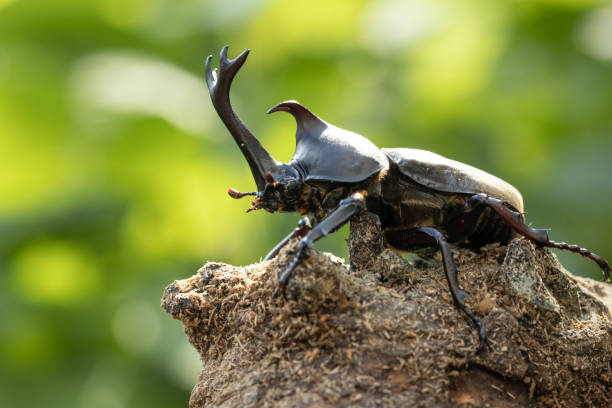Rhinoceros Beetle: The Armored Titans of the Insect World
Rhinoceros beetles are like the gladiators of insects. They showcase amazing natural engineering. With horn-like projections and impressive strength, they captivate entomologists and hobbyists alike. The Japanese rhinoceros beetle has become a popular choice as a pet. Their unique looks and calm nature attract many people. Below the surface of these
Table of Contents
Scientific Classification
- Kingdom: Animalia
- Phylum: Arthropoda
- Class: Insecta
- Order: Coleoptera
- Family: Scarabaeidae
- Subfamily: Dynastinae
- Common Name: Rhinoceros Beetle
Description / Physical Description
The rhinoceros beetle is a robust, armored insect that’s hard to miss. Its most striking feature is the large horns that adorn its head and thorax, which are primarily found in males. These impressive chitinous projections serve a dual purpose: they’re used for battling rivals and for flaunting during courtship displays.
When it comes to size, adults can vary quite a bit, measuring anywhere from 1.5 to 6 inches (4–15 cm), depending on the species. Their bodies are divided into three main sections: the head, thorax, and abdomen, all protected by a tough exoskeleton. This exoskeleton can have a matte or glossy finish and is often adorned with fine hairs or setae, particularly in the larval stage.
Despite their intimidating horns, rhinoceros beetles pose no threat to humans. They possess strong legs that help them dig and cling to tree bark. Their wings, neatly tucked beneath protective elytra, enable them to take short, powerful flights.

Range & Distribution
Rhinoceros beetles can be found on several continents, thriving in warm and humid climates. Their global presence spans:
Asia – especially in countries like Japan, China, Thailand, and Malaysia
Africa – found in various tropical areas
Australia – primarily in the northern regions
Americas – notably in Central and South America
Europe – mostly limited to the southern parts with milder weather
One of the most recognized species is the Japanese rhinoceros beetle (Trypoxylus dichotomus), which holds cultural significance in East Asia.
Habitat
Rhinoceros beetles thrive in environments rich with decaying plants, tree sap, and moist soil. You can typically find them in:
– Tropical and subtropical forests
– Temperate woodlands
– Farmlands and orchards
– Urban parks and greenhouses
The larvae spend a significant amount of time underground, sometimes for months or even years. They rely on nutrient-dense, decomposing wood and leaf litter to develop. As for the adults, they often hang out on tree trunks, munching on sap or fruit.
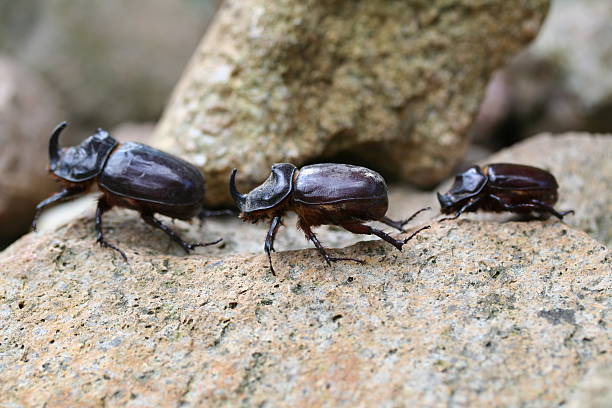
Diet
The diet of the rhinoceros beetle changes quite a bit from its larval stage to adulthood:
Larvae munch on decaying wood, compost, and all sorts of organic matter.
Once they become adults, they develop a taste for sweet, high-energy treats. Their favorites include tree sap, ripe fruits, and nectar, with bananas and mangoes being top picks.
For those who keep rhinoceros beetles as pets, a special jelly food is often provided. This jelly is packed with glucose and essential nutrients to keep them healthy and happy.
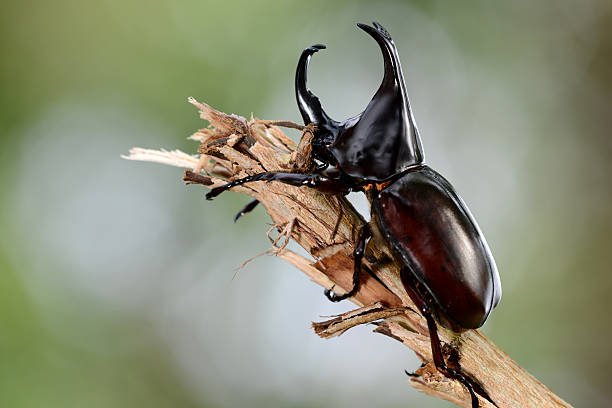
Behaviour / Lifestyle
- Rhinoceros beetles might look a bit scary, but they’re actually pretty chill and prefer to keep to themselves. These guys are mostly active at night, coming out at dusk to hunt for food and find a mate. During the day, you can find them tucked away under logs, leaves, or nestled in tree crevices.
- The males can be quite territorial. They often engage in ritualistic battles, using their impressive horns to toss rivals off branches. Thankfully, these skirmishes aren’t usually deadly, but they’re crucial for securing access to females and food.
- Their life cycle consists of three main stages:
- 1. Larval (grub) stage – where they hang out underground and focus on growing
- 2. Pupal stage – a time of transformation
- 3. Adult stage – where they concentrate on feeding, mating, and spreading out

Lifespan
Rhinoceros beetles have a relatively short adult lifespan but a long developmental cycle:
- Larvae: 12–24 months depending on the species and environmental conditions
- Pupae: 1–2 months
- Adults: Typically 3–6 months
In total, their lifecycle may span up to three years, though most of it is spent in the larval stage beneath the soil.
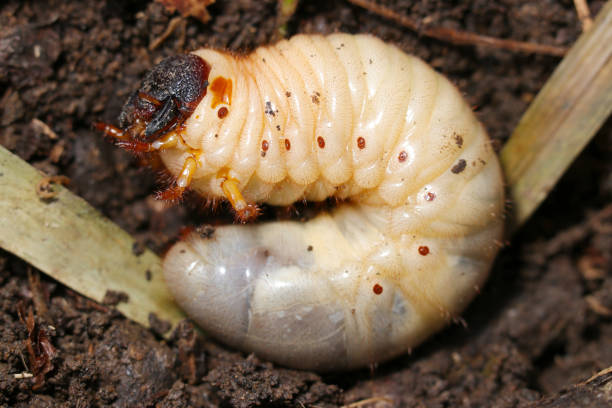
Adaptations
What really makes rhinoceros beetles stand out are their incredible adaptations:
Horned Morphology: Males use their impressive horns to battle rivals during mating contests.
Strong Exoskeleton: This tough outer shell protects them from physical harm and predators.
Burrowing Legs: Their legs are equipped with spines that help them dig and grip onto bark.
Flight Mechanism: Rhinoceros beetles have hidden wings tucked beneath their sturdy elytra, allowing them to take off swiftly despite their hefty bodies.
Incredible Strength: These beetles can lift objects that weigh up to 850 times their own weight! It really makes you think about just how strong they are. In fact, they rank among the strongest animals on the planet.
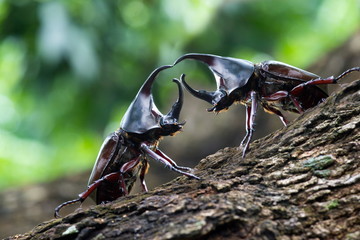
Mating & Reproduction / Reproduction & Lifecycle
Mating begins with male combat. Once a dominant male secures access to a female, copulation occurs, often during the night. After fertilization:
- Females lay 20–50 eggs in decomposing wood or humus
- Eggs hatch into C-shaped larvae within weeks
- Larvae feed voraciously for 1–2 years, undergoing several molts
- They then pupate, encasing themselves in protective earthen chambers
- Adults emerge, mate, and the cycle repeats
Reproductive success is closely tied to environmental conditions and food availability.
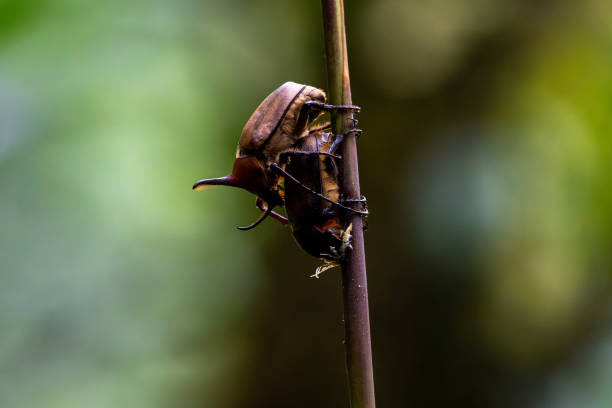
Predators
Even though rhinoceros beetles have tough armor, they still face threats from a variety of animals:
– Birds like crows and owls
– Reptiles such as lizards and snakes
– Mammals, including rodents and insect-eating marsupials
– Parasitic insects—especially wasps and flies—often go after their larvae
Humans also contribute to their decline by destroying habitats and, in some areas, collecting them excessively.
Conservation Status
When it comes to conservation status, most rhinoceros beetle species aren’t considered endangered. That said, some do face local challenges, including:
– Deforestation and the degradation of their habitats
– The use of pesticides in farming
– The illegal pet trade
– Climate change, which disrupts their microhabitats
Additionally, targeted measures, like pest control aimed at rhinoceros beetles in coconut and oil palm plantations, can unintentionally harm other species as well.
Interesting Facts
- Did you know some fascinating facts about the Japanese rhinoceros beetle? This little creature is quite popular in manga, anime, and children’s games!
- In various cultures, these beetles are seen as symbols of strength and bravery.
- In certain parts of Asia, people even hold rhinoceros beetle fights for entertainment. While these matches can stir up some controversy, they’re typically harmless.
- Interestingly, their horns show sexual dimorphism—females either don’t have horns or have much smaller ones.
- Despite their strength, these beetles are surprisingly gentle, making them easy to handle and perfect for educational purposes.
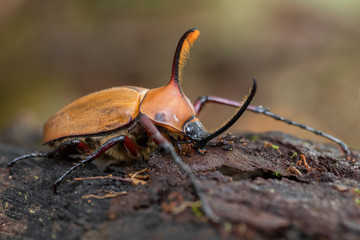
As Pets
Keeping rhinoceros beetles as pets is becoming quite popular in Japan, South Korea, and beyond. Their easy-going nature and fascinating behaviors attract both kids and enthusiasts alike.
Care Requirements:
Substrate: A deep, moist mix of soil and decayed leaves for burrowing
Diet: Beetle jelly, fruits, and tree sap
Humidity: 60–80%
Lifespan: Adults live for about 3–6 months, and you can even raise them from larvae
These little creatures don’t require much interaction and can thrive in plastic terrariums. Adding some bark and branches can really improve their living environment.
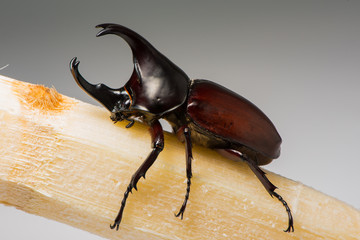
Classification of Species
The rhinoceros beetle subfamily (Dynastinae) includes over 300 species. Notable genera include:
- Dynastes (e.g., Hercules beetle)
- Trypoxylus (e.g., Japanese rhinoceros beetle)
- Xylotrupes
- Oryctes (some known agricultural pests)
- Megasoma
Each genus has different shapes, locations, and behaviors. However, they all share a distinct horned look and a burrowing lifestyle.
Subspecies
Let’s dive into some of the most well-known subspecies of beetles:
– Trypoxylus dichotomus septentrionalis, also known as the Northern Japanese rhinoceros beetle.
– Dynastes hercules hercules, famously referred to as the Caribbean Hercules beetle.
– Oryctes rhinoceros, or the coconut rhinoceros beetle, which is quite a pest in the Pacific islands.
– Xylotrupes gideon, found all over Southeast Asia.
Each of these beetles boasts its own unique characteristics, from the shape of their horns to their body size and color. They’ve all adapted beautifully to thrive in their specific environments.
Colours
Rhinoceros beetles display a range of colors, primarily:
- Glossy black
- Mahogany brown
- Golden yellow (especially in Hercules beetles)
- Matte gray with iridescent undertones
These colors are great for blending in with leaves and bark. They might also play a role in regulating temperature and attracting potential mates.
The rhinoceros beetle is truly an intriguing creature. It embodies a mix of strength, adaptability, and a touch of gentle mystery. Whether found in the wild or kept as a pet, rhinoceros beetles have a way of captivating anyone who lays eyes on them.

